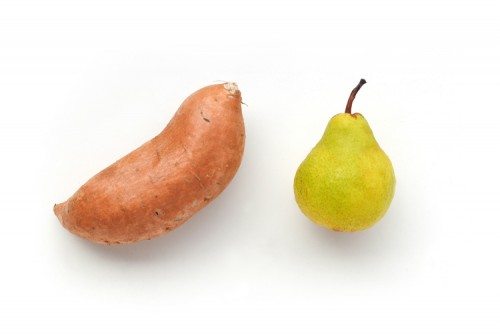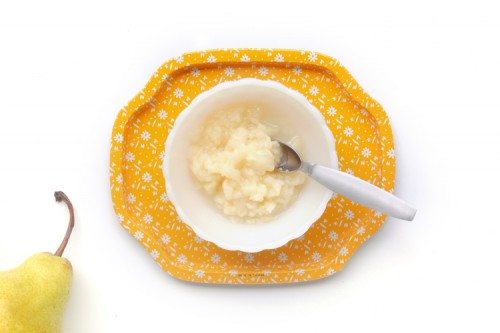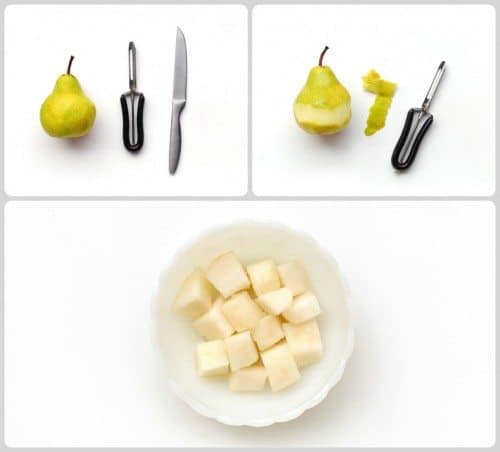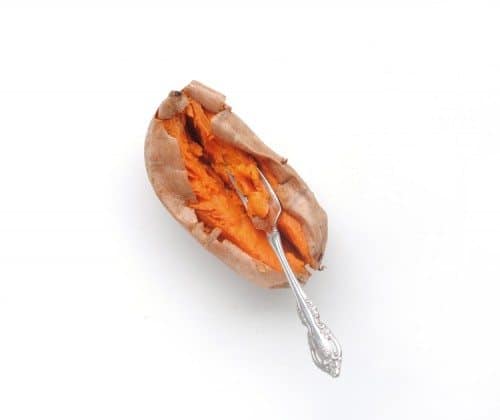Introducing Solids Foods (Fruits & Veggies) to Baby
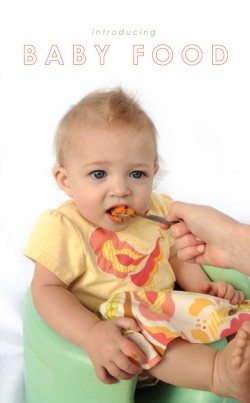
When should I introduce my baby to solid foods?
So for starters, let’s talk about when you should introduce your baby to solids. Friends and relatives most undoubtedly have varying opinions about when and what to feed your baby but leading health organizations recommend not introducing solids before 6 months of age. From there you can look for signs from you baby to see if she is ready, such as, does your baby watch you eat, following the food from the plate to your mouth? Does your baby still seem hungry even after his scheduled milk feeding? Can your baby sit well without support? All of these things might indicate that your baby is ready to try incorporating solids into his diet.
What types foods should I introduce first?
OK, so now you know when to introduce solids to your baby, but what types of foods should you start with? Many pediatricians recommend starting with grains but more and more have begun to see the value of fruits and vegetables (and even meat) as acceptable and healthy first foods for your baby. But whether you start with grain cereals or jump straight into fruits and vegetables you need to know a bit about which types of fruits and vegetables are appropriate for your baby and when.
(Update: we have updated the post to reflect the AAP’s most recent statement on dietary restrictions during a first child’s first year of life. Source)
The AAP no longer recommends limiting the introduction of foods considered to be highly allergic to babies older than 6 months of age unless the infant is considered to be at high risk of developing a food allergy (ie, infants with at least 1 first-degree relative [parent or sibling] with allergic disease). This includes delaying the introduction of foods that are considered to be highly allergic, such as fish, eggs, and foods containing peanut protein. The foods to continue to avoid through 12 months of age are cow’s milk, honey (because of botulism-risk), and foods that could pose choking hazards (those may remain risks for a few more years).
Fruits and vegetables are a great first food for baby.
Which one you want to try first is up to you. You might like to introduce vegetables as they are not as sweet as fruit and you might want your baby to get used to that taste first before introducing something sweeter. Or you might want to start with fruits precisely because they are sweeter and help your baby get interested in the idea of eating solids. You can then incorporate vegetables later. Whichever route your choose, just be ready to have patience and a sense of humor (as a lot of it will most likely end up on you!).
It’s also a good idea to follow the four day rule (Update: the AAP’s recommendation is to wait at least 2 to 3 days before introducing a new food), which is simply feed your baby the same food for four days to see if your baby has an allergic reaction to that particular type of food. Avoid introducing new foods during this time period so you can really pinpoint how your baby responds to this new type of food. If all is well, you can go ahead and keep feeding your baby this particular food while introducing new foods because you now know that this food is a safe option for your baby.
How Should I Prepare Fruits and Vegetables for My Baby?
It’s nice to have a blender, food processor, Baby Bullet, etc. on hand (I have a magic bullet that I kind of love) but I believe you can do a lot of baby food “pureeing” with a good old fashion fork. You really don’t have to go out of your way or spend a fortune on fancy gadgets to make food for your baby (unless you’re into that and it’s what gets you excited about the entire process. Then I say go for it!).
I have chosen to share two examples of great first foods for your baby, pears and sweet potatoes. Neither one of these requires much more preparation than an oven, or a microwave, and a simple fork for mashing. Other additional fruits and vegetables that are great first foods, and easy to mash or puree are:
Fruit: bananas, avocados, apples, peaches, plums, blueberries, cherries, apricots, melons & grapes.
Vegetables: white potatoes, peas, cauliflower and pumpkin. If making homemade baby food with carrots, butternut squash, and green beans please introduce after 6 months of age and use organic produce to minimize potential exposure to nitrates (source).
(As always, it’s always a good idea to consult with your family doctor or pediatrician before giving your baby any new foods, and discuss your child’s family history of food allergies, or if your child has a history of eczema or asthma.)
Many parents also opt to go with organic produce as it is pesticide-free and this safer for your baby. If this is route that you are interested in, I would suggest taking a look at Environmental Working Group’s (EWG’s) Shopper’s Guide to Pesticides in Produce. You can find a list of their “Dirty Dozen”, or produce that typically have the most pesticide, which would be best to purchase organic.
How to Make Homemade Pear Puree
Pears are a great first food for your baby as they are one of the safest fruits and are gentle on baby’s stomach (they do cause stools to be loose so avoid them if your baby is experiencing diarrhea). After purchasing pears from the supermarket you will most likely need to let them sit out in the open approx. 6 days to fully ripen. You will know it’s ripe when you feel a little ‘give’ when pressing your finger on it.
Once your pear is ripe, peel and core it, then cut it up into cubes. Place cubes in a microwave safe dish with very small amount of water. When fruit is soft you can then place it in a food processor until smooth or simply mash it with a fork, which is what I’ve done here. Stir well to avoid “hot spots.” You can test the temperature by placing a bit of the food on the inside of your wrist to see if it’s comfortable. When it is, place your pureed pears in a dish for feeding baby. And that’s it! So simple, right?
In fact, ripe pears are actually safe to mash or puree (with a food processor, etc.) without cooking for babies who are at least 6 months old. This approach actually helps to maintain some of the nutrients that could be lost when cooking. So feel free to try them this way as well!
How to Make Homemade Sweet Potato Puree
I really love sweet potatoes as a first food for babies. They are loaded with great nutrients, are sweet and yummy for baby and very simple to prepare. Start by preheating the oven to 375 deg. Scrub and pick your potato with a fork then place in the oven for about 45 min. or until it feels soft.
Now all you need to do is split the sweet potato down the middle and scrape out the insides while the potato is still warm. Place in a bowl and mash with a spoon or fork. It’s now ready to serve! And chances are your, baby will love this food straight away.
(On a hot day you might not want to use the oven. No problem. Just peel the potato, cut into cubes and then steam or boil it until it is soft and ready to mash. Many prefer the steam and puree technique for preparing baby food and this is also a really great way to go).
As you are introducing your baby to vegetables it can be fun to mix them with fruits, and try different combinations, such as sweet potatoes and melon, carrots and apricots, butternut squash and apples, and so on. Just be sure not to add any salt, sugar, or honey into the mix as these could be harmful (hello, honey!) and at the end of the day are not necessary.
Feeding Your Baby Solids for the First Time
Now that you have prepared your first solid food for your baby, you are now ready to serve it her. I would pick a time of day when neither you or your baby are stressed and can spend a little time just focusing on this. You don’t want your baby to be too hungry either or she will be too frustrated to really take the time to try something new. You want to take the edge off a bit by giving them about half as much milk as you would normally feed them at the time.
You can start with giving them solid foods twice a day and work up to three times a day when they are about 9 months old. But remember, every child is different so working with them at their pace is important. Breast milk and/or infant formula is still very important during the first year and will be your baby’s primary source of nutrition. A good idea is to to start off with solids and then follow-up with nursing or a bottle.
OK, so to get started, sit your baby up with support in your lap or a high chair or even a Bumbo Baby Seat (my favorite). Now spoon feed her one bite at a time. This is the fun part. They will either eat it up eagerly or turn their face away in disdain, or even try it only to then spit it out all over you. Be patient and try to keep a happy attitude and tone, as your baby will sense any frustration. Keep trying until you sense your baby is done.
Serving sizes for your baby don’t need to be all that large in the beginning. You can start with a couple of teaspoons of fruit and vegetables, gradually working up to ¼ to ½ cup in 2-3 feedings a day. If your child doesn’t like what she’s given, don’t force her to eat anymore but do try the same food again the next day or a few days later.
It is safe to store leftover baby food in the refrigerator so long as it has not come in contact with your baby’s saliva. Just be sure that it your refrigerator temperature is below 40 degrees, as higher temperatures can invite bacteria. You can then keep it in the fridge for about 24 hours after making it.
Now relax and sit back. You and your baby have now begun the exciting adventure of eating solid foods. It’s an exploratory time for the both of you and one that goes by way too fast, so take a breather and enjoy this special time with your baby.
*Thanks to my darling niece for being my taste tester and model.


